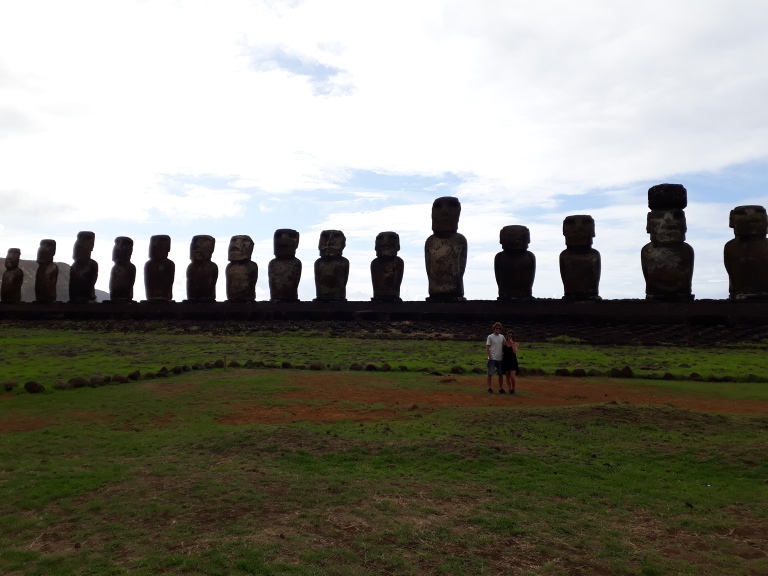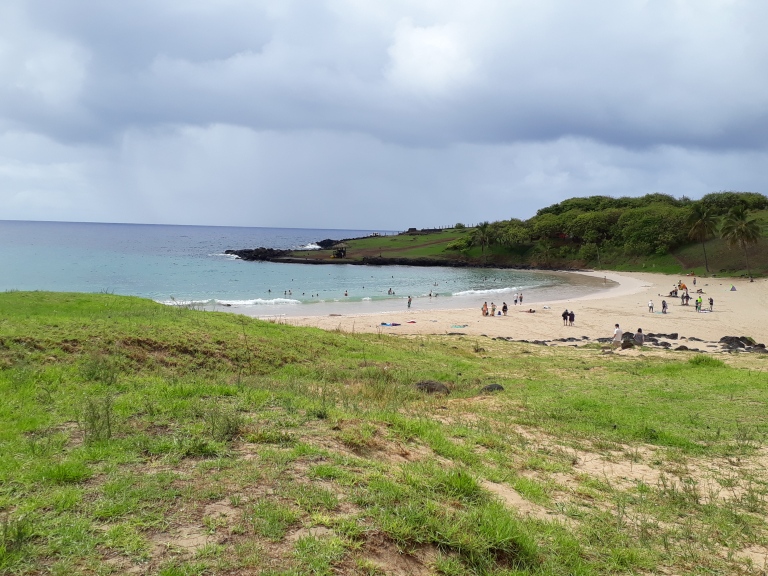As you might have understood by now, if you have been reading my previous posts, Rapa Nui – better known as Easter Island – really stole my heart! But don’t worry, this will be the last post on this magic place…at least for now!
From swimming, to learn more about the history and culture, to exploring the island’s volcanoes, there is so much you can do in this place. In my previous post, I talked about 13 unmissable experiences in Rapa Nui, but today, I’m going to talk about the top 10 sights that you absolutely need to check out.
Ahu Tongariki
Ahu Tongariki is the most famous and largest Moai complex on the island. This Ahu has 15 Moai statues and was destroyed twice in the past – first by a civil war and then by a tsunami – but was completely restored in the 90s.
Here you can see these 15 giants, all in different sizes and shapes, with the amazing background of the Pacific Ocean and two volcanoes: Poike Volcano on the left and Raraku Volcano in front of the Ahu. This is a premium spot to watch the sunrise on the island.

In the same site you can also see another Moai lying flat on the ground. Even though you can’t get obviously touch it, you can get close enough this Moai, which really gives you a sense of how big these statues are.
Finally, here you can also see the Travelling Moai. This Moai was first shipped to Japan, where it stayed for a while, and when it was brought back to Easter Island, it was used for experiments aimed at finding out how Maois were transported in the past, so it was moved a few times on the site.
Rano Raraku
Another must see spot on Easter Island, and probably the most seen on travel guides, is Rano Raraku.
Rano Raraku is one the most important sites on the island as it’s the core of Rapa Nui megalithic art, where almost all Moais were carved, before being transported somewhere else. This is where Rapa Nui people found the raw materials for building the Moais and used this place as a workshop.

Rano Raraku is a very nice place to enjoy a walk and learn about the story of the island. With its hills and slopes and dozens of Moais of different sizes, shapes and position, is a unique place on Easter Island.
Rano Kau Volcano and Orongo
Rano Kau is one of the volcanoes on the island and it’s considered the last have for biodiversity on Rapa Nui. The microclimate in this crater creates ideal levels of humidity and light for plants. In addition, the crater gives protection to plant and microorganism from wind and humidity coming from the ocean.
Take your time to walk on its crater to admire the immensity and intense blue colour of the Pacific Ocean and stop at the official mirador (viewpoint).
In this site, you can also visit Orongo, a ceremonial village made up of 53 basalt stone slab houses. This village was never inhabited and it was used only for a couple of weeks during the year, at the start of the spring. The design of the building here clearly revokes the one of harevaka (boat houses), common all over the island.
Why is Orongo famous? Although megalithic art was one of the most important forms of expression on Rapa Nui, from the XVI century, it became simply a political and religious expression and it was soon replace with the cult of Make-Make God, associated with fertility, spring and migratory birds. Orongo soon became the main centre for this cult, marking an important place for the birth of a new era on the island.
Te Pito Kura
Te Pito Kura literally means Navel of Light. Te Pito Kura is an archaeological complex located approximately 2Km southeast of Ovahe beach.
There are two mains things to see here. The first one is the largest Maoi ever build on the Easter Island. This Moai is about 10m tall, but it currently lies face down on the ground as it collapsed.
However, this isn’t the main attraction here. Not too far from the Moai, there is a large ovoid shaped stone, which measures 80 cm in diameter and it is this rock that gave the name to this site, due to its special properties. As a matter of fact, this rock is believed to have a high concentration of a magnetic and supernatural energy called mana.

The stone contains high levels of iron and, for this reason, it warms up more than others and causes compasses to behave differently. This stone quickly became famous, and many tourists and visitors went there to touch it to try and capture its energy. This energy was also related to fertility. To try and preserved the site, however, the stone has been closed off and it is no longer possible to touch it.
Ahu Tahai
Even though it’s a pretty spot at any time of the day, Ahu Tahai is a very popular spot for sunset watching on Easter Island. You can find this Ahu just a few steps away from the Hanga Roa villages and here you’ll find lots of people who are watching the sunset.
The ahu here is one of the oldest archeological complex on the island, but it’s not all that there is to see. Next to it, you can still see the remains of one of the typical boat-houses of the island, and a small cave, that was used as a shelter.
This site actually has three Ahus: Ahu Vai Uri, Ahu Tahai and Ahu Ko Te Riku. Ahu Vai Uri has five Moais statues, all of different sizes and shapes. Ahu Tahai has a single solitary Moai about 4.5 m high, which is still believed to transmit the mana magical energy. Finally, Ahu Ko Te Riku is the most recognisable one, with its reddish hat and eyes. Did you know this is the only Moai on the island with eyes?

Ahu Nau Nau
Ahu Nau Nau isn’t one of the most famous Moais complex on Easter Island, but it certainly is one of my favourite.
Located at Anakena beach, this ahu is surrounded by palm trees, white sand and turquoise water. Head here to admire this well preserved Ahu and to enjoy a swim in one of the best spots on the island. Did you know this is one of the first Ahus to be raised on the island in modern times?
Ana Te Pahu and Ana Kakenga Caves
Easter Island is full of volcanic caves, which formed as lava tunnels created after rocks solidified around a flowing stream of molten lava. There are a lot of caves here, but two are the best ones to see: Ana Te Pahu and Ana Kakenga (I already talked about this here).
Ana Te Pahu is the largest cave on the island and is famous for its overgrown garden of sweet potatoes, taro and bananas.

Ana Kakenga has two openings that acts like windows on the Pacific Ocean – such an unmissable view and perfect spot for your Instagram picture!
Anakena Beach
Anakena Beach is the most popular swimming spot on Easter Island, with white sand, palm trees and blue water. As we heard this was the main swimming destination on the island, we imagined this was going to be full of people and ore touristy. However, we were surprised and happy to see that this place was still pretty untouched and there weren’t too many people – maybe because we weren’t there during high season.

If you are looking for other places to swim on Rapa Nui, check out this post.
Ahu Akahanga
Is considered one of the most important Ahus on the island if you want to see the Moais from close. In this area, Moais were only up to 18 m away from the coast and so, over time, they were knocked down by waves. Unlike other places on the island, where these giants now lie all face down on the ground, here you can find some between 5 and 7 meter tall statues that lie face up.
Moreover, according to a local legend King Hotu Mata is buried here and you can fins his tomb just by the coast.

Hanga Roa
Finally, I’m adding Hanga Roa – the only inhabited village of the island – to this list. While you are “forced” to stay here, not many people actually take the time to explore this cute little village. However, this place has a lot of spots worth visiting.
From the Polynesian church, to Pea Beach, to the Poko Poko Natural Pool, some Ahus and small streets, Hanga Roa has a few hidden gems.
YOU MIGHT ALSO LIKE:
- Easter Island – Frequently asked questions
- 4 spots to go for a swim on Easter Island (Rapa Nui)
- All my destinations in Chile
- 6 reasons why you should visit Chile
- Chile – All you need to know
- If you like swimming
- My year long backpacking trip
- Destinations in South America
- Nature & Outdoors adventures destinations

Love go there. Majestic.
I also have great memories of my stay on Easter Island. Exploring the island and being close to the moai, one feels like travelling back in time. It is also intriguing to be confronted with the mysteries of the past, which have remained unexplained due to a lack of reliable sources and left to the imagination.
Incredible photos! It has been a dream of mine to visit there… hopefully one day!
I’m sure one day! It’s really worth a visit 😊
I am SO jealous!!! Looks amazing